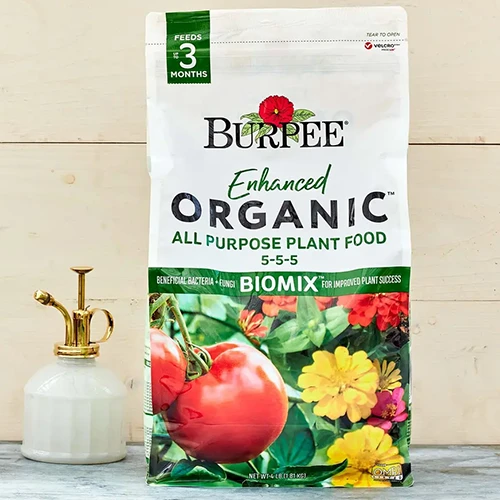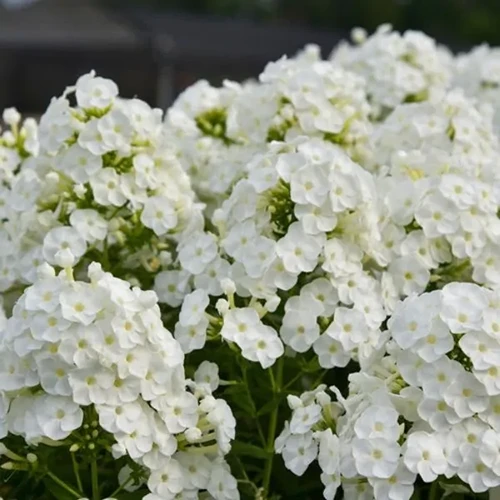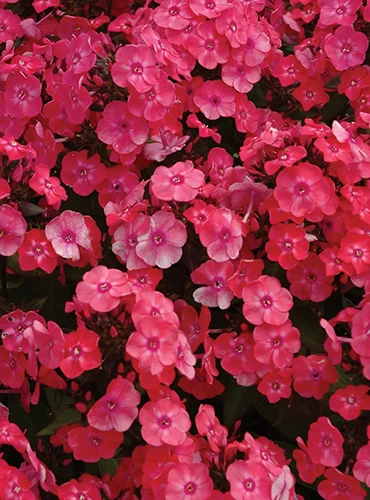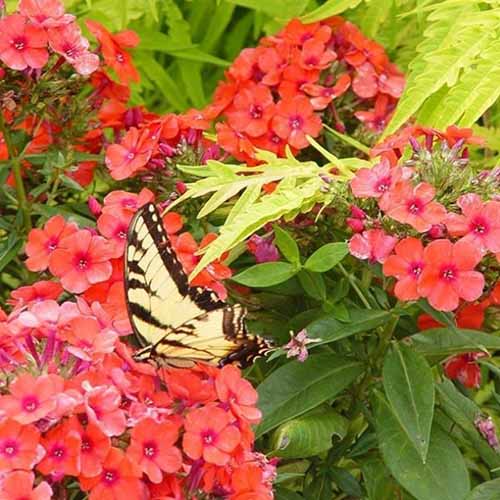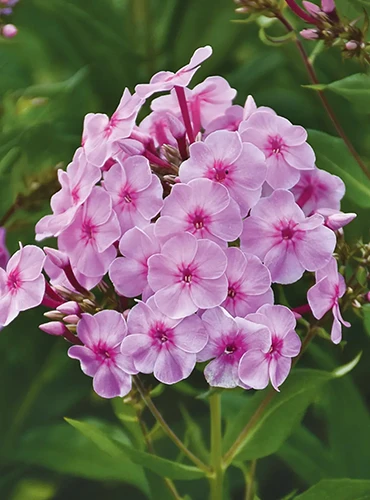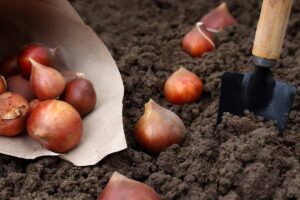Phlox paniculata
Tall and stately with sweetly fragrant clouds of billowing blooms, garden phlox (Phlox paniculata) is an upright, showy plant that flowers throughout the hot days of summer.
A North American wildflower that’s become a classic, garden or tall phlox is easily grown and produces large clusters of ornate flower heads.

We link to vendors to help you find relevant products. If you buy from one of our links, we may earn a commission.
These clump-forming perennials are highly attractive to pollinators such as bees, butterflies, and hummingbirds, with small, tubular flowers densely packed into flattened, round, or pyramid-shaped panicles.
Flowering for six weeks or more from July to September, they add blooms in luscious, tropical shades of lavender, pink, rose, scarlet, orange, purple, and white – right when many flowers start to hide from the heat.
A stellar performer for sunny borders, foundations, and islands or in butterfly and cottage gardens, phlox is typically grown in temperate areas – it needs moist soil and can’t handle drought.
These plants do have a bit of a reputation for being prone to powdery mildew, but breeders are continuously developing new cultivars with improved mildew resistance, which extends their range into warmer and more humid USDA Hardiness Zones.
So if you’re ready to add some colorful, long-lasting flowers to your landscape, join us now to read all about how to plant and grow garden phlox!
Here’s what you’ll learn about up ahead:
What You’ll Learn
What Is Garden Phlox?
Garden phlox (P. paniculata) is a species of upright, clumping herbaceous perennials in the Phlox genus that grow two to four feet tall with a spread of two to three feet.
Other common names include fall, late, perennial, summer, tall phlox, indicators that P. paniculata is the last of the cultivated species to flower in the growing season.

Large terminal clusters of small, tubular, five-petaled flowers have a sweet scent and bloom from July to September. Flowers are available in pretty pastels or saturated tropical shades of blue, lavender, orange, pink, purple, red, and white.
Dark green leaves have a pointed, elliptical shape, oppositely arranged on stiff stems that require no staking, although container plants and those grown in shade may need a stake or two to keep outer stems upright.
These hardy plants are woodland natives and need consistently moist soil to thrive, struggling in areas where moisture is inadequate.
Typically grown in temperate zones, they’re easily cultivated in the right conditions but may suffer from powdery mildew, particularly in heat and humidity.
Many of today’s cultivars are bred for improved disease resistance, making them better suited for hot and humid regions – but they still don’t like hot, dry soil.
A magnet for pollinators, garden phlox is a favorite of bees, butterflies, and hummingbirds.
Plants exhibit decent resistance to deer, though rabbits and deer can cause problems by chewing on tender new growth and foliage. They tend to avoid the fragrant flowers.
If marauding herbivores are causing damage in your landscape, be sure to read our guides for tips on deer-proofing your yard and how to keep rabbits away.
Plants die back to the ground in winter and are hardy in USDA Zones 3 to 8, with some cultivars hardy only to Zone 4.
Several other species in the Phlox genus are widely cultivated as well.

In early spring, the creeping and moss varieties (P. stolonifera and P. subulata) add stunning blankets of color to ground covers and rock gardens.
The next in the genus to flower is annual or medium phlox, P. drummondii, with bright blooms from early spring to early summer.
Plant some of these with the late-flowering garden varieties to enjoy easy-care phlox flowers for the entire growing season.
Cultivation and History
Endemic to the woodlands of the central and eastern US, P. paniculata was the first phlox species to be bred by European growers, with cultivars appearing in England by the early 1800s.
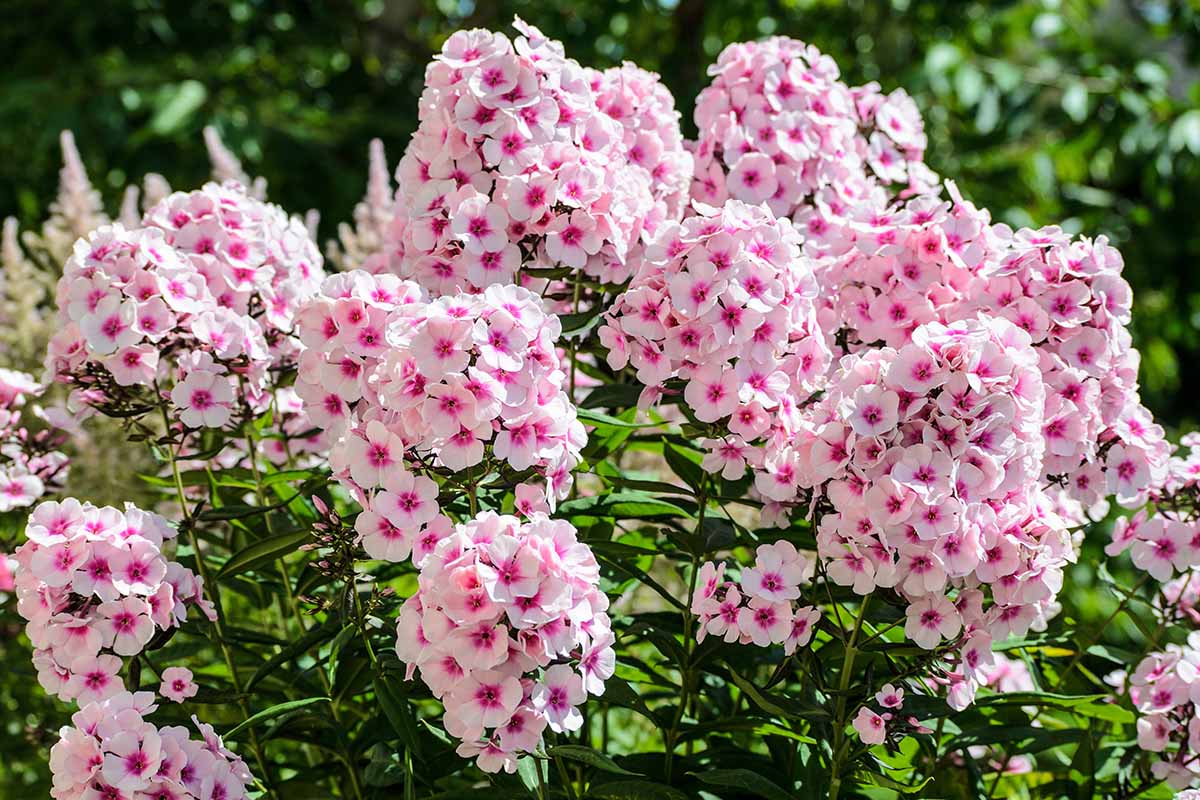
The genus name comes from the Greek word for flame (phlox), referencing the brightly colored flowers of native species.
The species epithet paniculata refers to plants that flower in panicles.
There are hundreds of P. paniculata cultivars and dozens have received the prestigious Award of Garden Merit from the Royal Horticultural Society, including beauties like ‘Flamingo,’ ‘Peacock Cherry Red,’ and ‘Prince of Orange.’
Today’s breeding takes place mainly in the Netherlands and the US, with an emphasis on developing dwarf and mildew-resistant varieties.
Garden Phlox Plant Propagation
The best methods of propagating tall phlox are by taking basal stem cuttings, root division, or sowing seeds.
From Basal Stem Cuttings
Take basal stem cuttings in spring after new growth is at least six inches tall.
Use clean, sharp scissors or shears to cut four-inch stems close to the ground, cutting just above a set of leaf nodes.
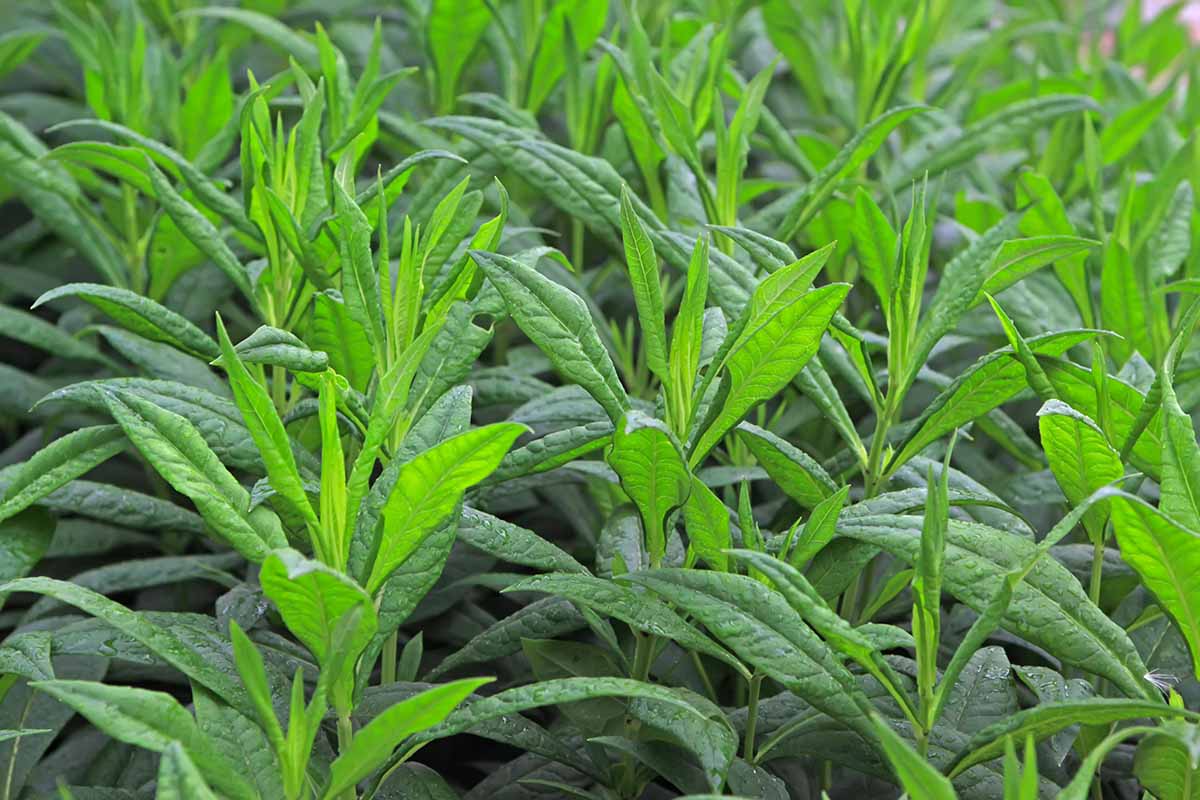
Strip away leaves from the lower half and dip the cut end in rooting hormone if desired.
Prepare small pots or trays with a finely textured, sandy potting mix. Moisten the soil thoroughly but not to the point of being wet.
Insert cuttings until the lowest leaves are half an inch above the soil and space so leaves aren’t touching. Firm the soil gently around the stems.
Place in a brightly lit location out of direct sunlight.
Keep the soil lightly moist until the cuttings root, in three to five weeks.
Once rooting is established with new growth, transplant out to the garden after hardening off.
Via Root Division
Root division is best performed in early spring, just as new growth appears, or in early autumn after flowering has finished.
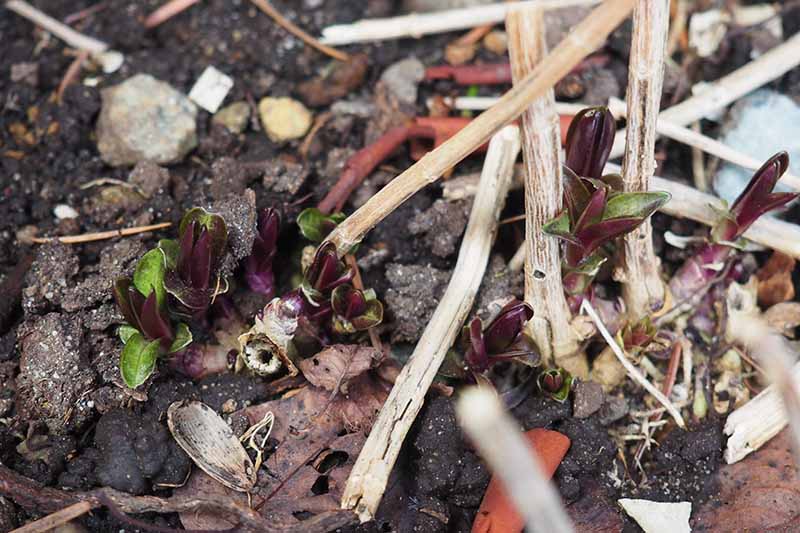
Prepare the planting site by digging down 12 inches to loosen the soil. Break up any lumps and discard stones and debris.
Mix in a shovelful of compost or well-rotted manure to enrich the soil.
To help keep the soil moist, mix in a shovelful of moisture-retentive materials such as coconut coir, peat moss, perlite, or vermiculite.
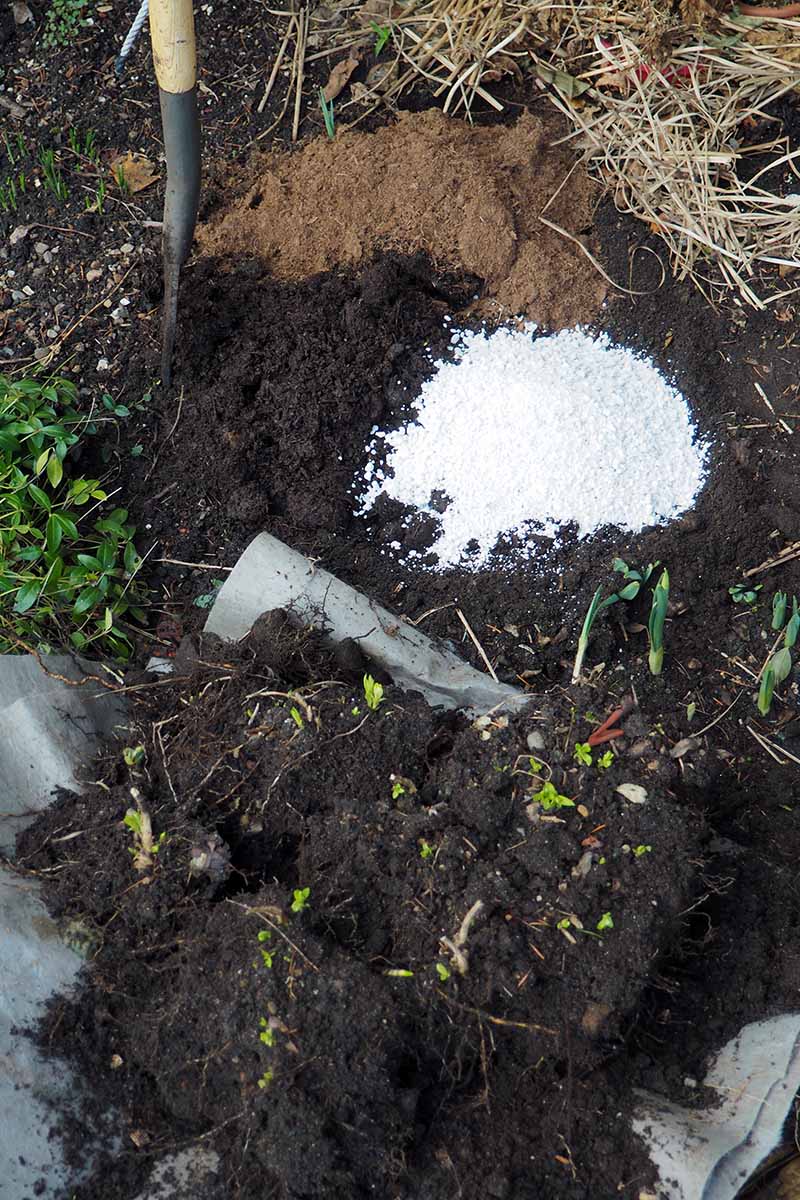
Add in a shovelful of granite chips, landscape sand, or pea gravel to improve drainage if needed.
Stir in one or two tablespoons of bone meal for healthy root development.
When the planting area is ready, take your divisions. Use a clean, sharp spade or garden fork inserted a few inches outside of the root zone to lift clumps.
Divide each clump into equal sections with a clean, sharp knife or spade. Each section needs at least two or three strong shoots and a portion of healthy roots.

Replant divisions immediately.
Place the divisions with the crown one to two inches below the soil surface then backfill and gently firm the soil.
Water lightly to settle in place.
Springtime divisions need to be kept well-watered through spring and summer.
Fall divisions should be given a four- to six-inch layer of mulch, such as bark mulch, leaf mold, or straw, to prevent damage from freeze/thaw cycles. Remove winter mulches in early spring.
From Seed
To direct sow seeds, plant in spring after all danger of frost has passed or in fall, about a month before first frost.
Scatter seeds evenly over prepared soil then barely cover with one-eighth of an inch of soil.

Water gently to moisten the soil and seeds.
When seedlings are six inches tall, thin to 10 inches apart.
To start seeds indoors, sow six to eight weeks before your last frost date.
Fill seed cells or trays with a finely textured seed-starting mix.
Sow seeds evenly over the top or place one to two per cell, and barely cover with one-eighth of an inch of soil.
Water gently to moisten the soil, but don’t let it become overly wet.
Place pots or trays in a bright location out of direct sunlight and maintain temperatures of 65 to 70°F. Germination will take up to 21 days. Maintain soil moisture throughout this period.
Once the seedlings are large enough to handle, with at least two sets of true leaves, transplant individually into small four-inch pots filled with the same mix and continue to keep the soil moist.
Once overnight temperatures stay above 50°F, harden off seedlings for a week before transplanting out to the garden as described below.
Hardening off to outdoor conditions involves providing 30 minutes to one hour of exposure on the first day before bringing them back inside, and then adding to the exposure gradually over each consecutive day to follow until they can withstand conditions full-time.
How to Grow Garden Phlox Flowers
For the best flowering, set garden phlox in a full sun location in humus-rich and moist but well-draining soil with a neutral pH of 6.0 to 8.0.

Allow ample spacing between plants to ensure the adequate air circulation needed to thwart the spread of powdery mildew. Provide light afternoon shade in areas with very hot sunshine.
Prepare the planting site as outlined in the Root Division section above, amending the soil with compost, moisture-retaining matter, and drainage materials as needed.
Mix in one to two tablespoons of bone meal for strong, healthy roots.
Set plants in place with the crown one to two inches below the soil line, spacing plants 12 to 24 inches apart depending on the cultivar. In heat and humidity, proper spacing is crucial to prevent the spread of unfriendly fungi.
Backfill with soil and firm gently.
Water thoroughly and keep the soil moderately moist throughout the growing season – phlox does not do well in dry or hot soil.
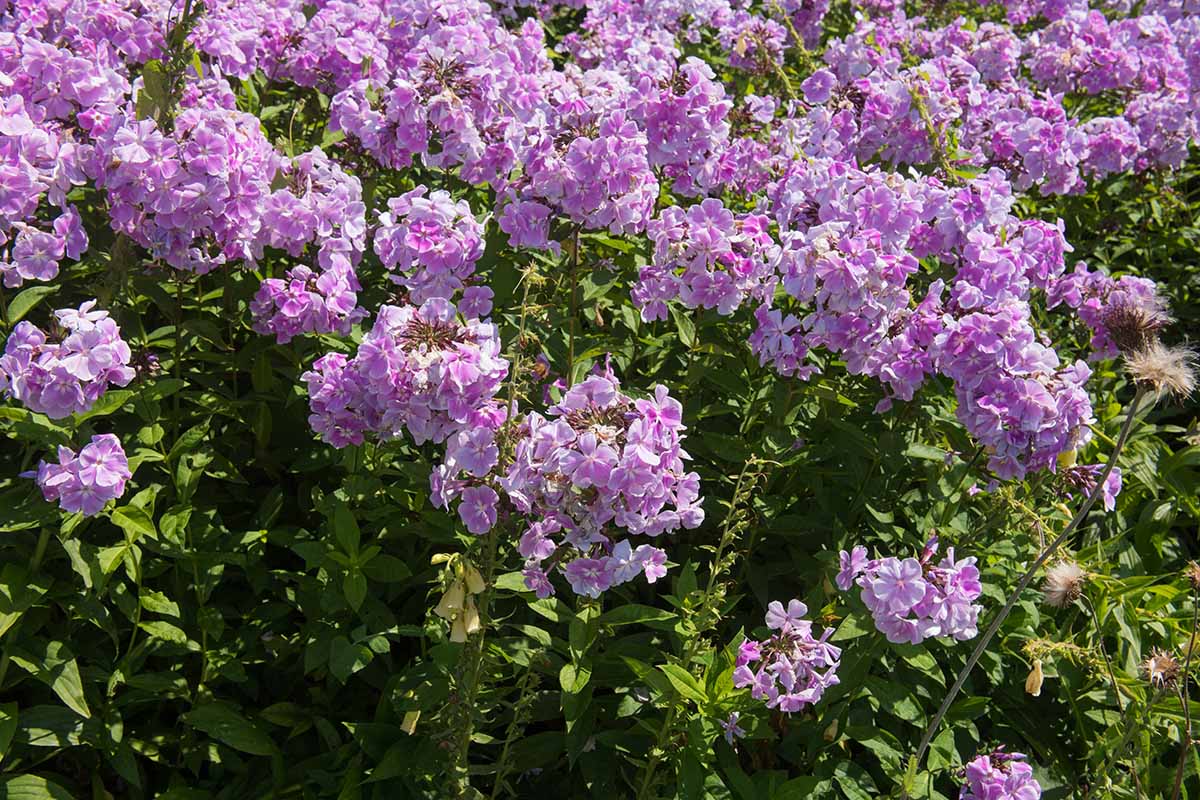
Add a two- to four-inch layer of mulch over the root zone to help retain moisture and prevent roots from drying out. Use mulch materials such as compost, leaf mold, or straw.
Avoid overhead watering or watering late in the day to minimize the chances of spreading powdery mildew spores.
For container growth, choose dwarf cultivars.
Use pots with drainage holes. I cover the holes with a two-inch layer of drainage materials such as broken pottery or pebbles.
Fill with a humus-rich, moisture-retentive, and well-draining soil and mix in one to two tablespoons of bone meal.
Set plants as outlined above then water to settle in place.
Place containers in a full sun location and water regularly to keep the soil lightly moist.
Growing Tips
In the right conditions, garden phlox is easy to grow – the following tips help provide optimal conditions for the best flower production.
- Plant in full sun.
- Space plants adequately to provide ample air circulation.
- Keep the soil moderately moist and apply a summer mulch to keep roots cool and help retain moisture.
Now let’s look at what garden phlox needs for regular maintenance.
Pruning and Maintenance
Phlox plants are heavy feeders and give their best display with two feedings during the growing season.
Along with enriching the soil with organic matter when planting, feed clumps in early spring just as new growth emerges from the soil and again in early summer just before the buds open up.
In spring, use a two-inch layer of compost or manure spread over the root zone, an application of liquid or water-soluble fertilizer, or use slow-release pellets with a balanced formula like 10-10-10 NPK.
Burpee Enhanced Organic All-Purpose Plant Food
Burpee Enhanced Organic All-Purpose Plant Food has a formula of 5-5-5 NPK and lasts for three months. It’s available at Burpee in four-pound bags.
For the summer feeding, do not use slow-release granular fertilizer.
Liquid fertilizers release nutrients immediately, giving flower buds a needed boost before opening, and compost and manure release nutrients quickly each time plants are watered.
Agro Thrive Organic General Purpose Liquid Fertilizer
Agro Thrive has a five-gallon bucket of Organic General Purpose Liquid Fertilizer with a 3-3-2 NPK formula that’s available at Home Depot.
If needed, add a two-inch layer of mulch to keep the soil cool and moist. Materials like bark mulch, shredded leaves, or straw make a good summer mulch.
Phlox self-seeds readily, but cultivar offspring usually aren’t true to the parent plant. Deadhead spent flowers to prevent unwanted reseeding.
Pruning isn’t required, but for bushier plants with more flowers, cut back up to half of the stems by one-third in mid-spring to force branching and bud development.
Use clean, sharp shears to prune away stems from the outside perimeter and a few from the interior to improve air circulation.
Also, due to their heavy feeding, divide and reset clumps every four years to rejuvenate plants with fresh, rich soil. Follow the steps in the Root Division section above to revitalize plants.
Cut away dead and decaying plant matter in late fall and clean beds thoroughly to prevent overwintering pathogens. Stems can be cut down to the ground.
In regions with freezing temperatures, provide plants with a four-inch layer of winter mulch, such as bark mulch, sawdust (from untreated lumber), straw, or pine boughs.
Clean away winter mulches in early spring after new growth emerges.
For containers, feed as outlined above and provide a summer mulch to help retain moisture.
Before winter arrives, clean away dead plant matter and move the pots into a sheltered spot such as against a fence, foundation, or wall.
Apply a thick, four-inch layer of winter mulch to protect the roots from freeze/thaw cycles, and insulate pots as needed to prevent damage from freezing temperatures.
In early spring, remove the mulch and move pots back to their growing location.
Garden Phlox Cultivars to Select
There are hundreds of gorgeous P. paniculata cultivars to choose from! The following is a small sample of robust, mildew-resistant varieties.
Backlight
Long-stemmed beauties, ‘Backlight’ shines in the landscape with radiant white flowers sporting small chartreuse eyes that bloom from early to late summer.
Growing 24 to 36 inches tall and spreading 18 to 24 inches, the fragrant flowers form in large pyramid-shaped panicles that are beautifully supported on tall, strong stems covered in dark green foliage.
A serene selection for beds, foundations, islands, and cottage gardens, be sure to plant some in the cutting garden – you’ll want plenty for floral arrangements as well. Hardy in Zones 3 to 8.
Containers of ‘Backlight’ are available at Nature Hills Nursery.
Desire
A compact rebloomer in the Bambini® series, ‘Desire’ (aka ‘Versde’) develops dense clumps loaded with fragrant flower heads of deep, rosy magenta-to-purple and light flares around the eyes.
Plants are strongly branching with a dwarf habit of only 10 inches tall and wide. They flower from early summer until autumn and deadheading encourages reblooming.
A strong choice for containers and planters or massed in beds, borders, and edging, ‘Desire’ is hardy in Zones 3 to 8.
Three-packs of bare root plants are available at Home Depot.
Glamor Girl
From the Garden Girls™ collection, ‘Glamor Girl’ adds allure with large domes of hot coral pink flowers, with older blooms fading to a pretty candy pink.
The handsome dark green foliage has strong purple tones. Plants flower from early to late summer, and rebloom with deadheading.
‘Glamor Girl’ grows 24 to 36 inches tall with a 24-inch spread. A superb choice as a specimen or massed for beds, borders, and butterfly or cottage gardens, the fragrant blooms also make a top-notch cut flower.
Garden Girls™ selections are a good choice for growing in heat and humidity. These plants are hardy in Zones 4 to 8.
Plants in nursery containers are available at Burpee.
Orange Perfection
A hardy plant with delightful salmon-orange flowers, ‘Orange Perfection’ blooms vigorously from early summer into fall.
The fragrant flowers form large globes on vigorous stems that grow 24 to 36 inches tall with a similar spread.
An eye-catching choice as a specimen plant or massed into beds, borders, foundations, and islands, the long stems also make beautiful cut flowers. Hardy in Zones 4 to 8.
Plants are available at Nature Hills Nursery.
Uptown Girl
Another selection from the Garden Girls™ collection, ‘Uptown Girl’ struts in style with glorious pastel pink flowers and rosy pink eyes.
A good rebloomer, the perfumed, domed panicles rise on strong purple stems with a mature height of 32 to 36 inches and spread 28 to 32 inches.
‘Uptown Girl’ is a strong performer in heat and humidity and makes an excellent choice as a border plant, cut flower, or mass planted in beds and cottage gardens. Hardy in Zones 3 to 8.
Bare root plants are available at Burpee.
Managing Pests and Disease
In ideal conditions, garden phlox has few problems – but there are some issues to watch for.
Spider mites can make an appearance, particularly in hot, dry conditions. Infestations occur on the underside of leaves and cause yellow foliage and general plant decline.
Spray with an insecticidal soap to control infestations and ensure the soil stays moist to prevent plant stress. In areas with hot sun, provide light afternoon shade.

The most common disease to watch for is powdery mildew.
Caused by Erysiphe cichoracearum fungi, it appears as a white to gray fuzzy mold on stems and foliage. Infected plants are weakened and common symptoms include leaf drop and stem collapse.
Powdery mildew is most prevalent in areas with high humidity, and the best cure is prevention.
Choose mildew-resistant varieties, like the ones in our Cultivars to Select section, and avoid overcrowding plants – adequate air circulation is a must. Remove and safely discard infected leaves and stems promptly.
Also, if your plants have had powdery mildew in the past, you can use a preventative homemade spray to minimize reappearances. Apply in late spring when temperatures are starting to heat up.
In a large spray bottle, add one quart of water, one tablespoon baking soda, and half a teaspoon of mild dish soap.
Shake well to mix and spray on plants, including the underside of leaves – you want to do this before the mildew appears.
Best Uses for Garden Phlox Plants
Perennial phlox is an excellent, low-maintenance plant that’s widely used in the background of mixed beds, as a border, and in butterfly, cottage, and rain gardens.
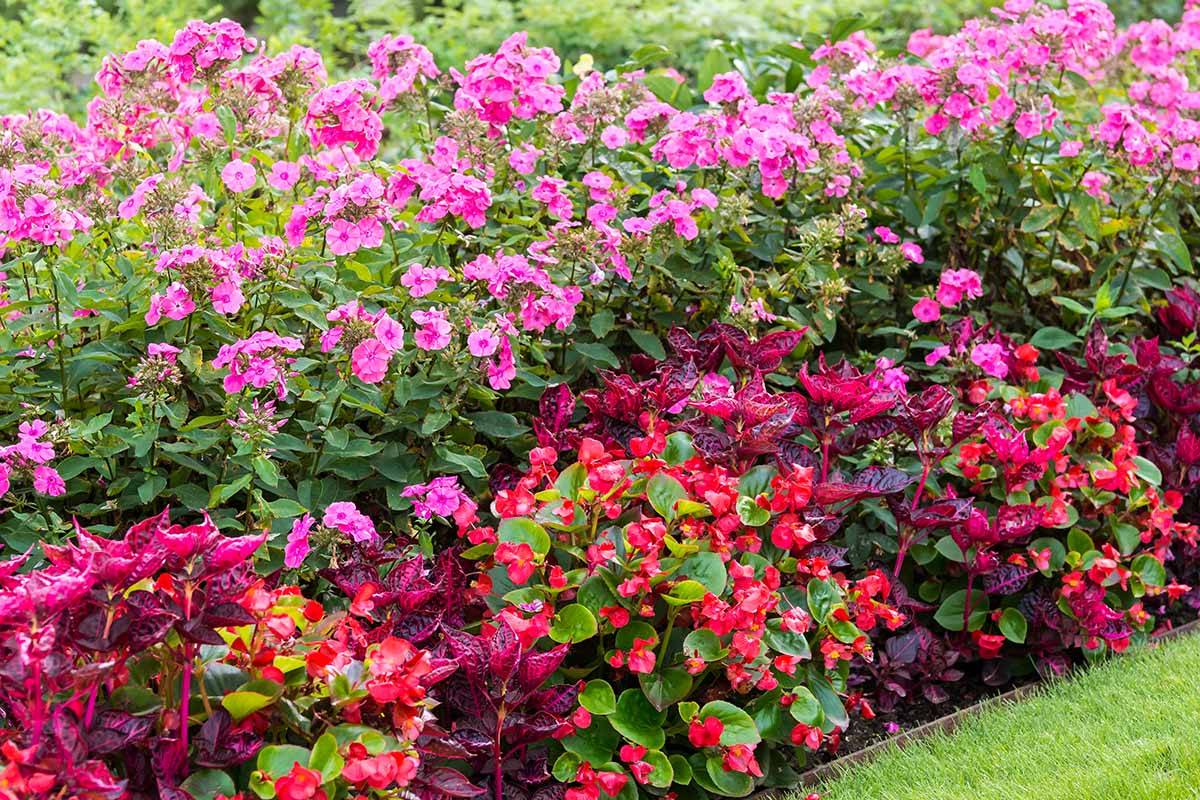
Their long bloom time also makes a handsome addition to foundation or island plantings and the long-lasting flowers are a must-have for the cutting garden.
For containers, patio planters, and window boxes, use the compact dwarf varieties and taller ones for beds, borders, and foundations.
Quick Reference Growing Guide
| Plant Type: | Herbaceous flowering perennial | Flower / Foliage Color: | Blue, magenta, mauve, orange, pink, purple, red, white/dark green, sometimes tinged in purple |
| Native to: | Central and northeastern US | Water Needs: | Moderate |
| Hardiness (USDA Zone): | 3-8 | Maintenance: | Low |
| Bloom Time/Season: | Early summer to early autumn | Soil Type: | Humus rich |
| Exposure: | Full sun | Soil pH: | 6.0-8.0 |
| Time to Maturity: | 180-200 days (seed) | Soil Drainage: | Well-draining |
| Spacing: | 12-24 inches, depending on cultivar | Attracts: | Bees, butterflies, hummingbirds |
| Planting Depth: | 1/8 inch (seed), 2 inches (crown of transplants) | Uses: | Beds; borders; islands; foundations; butterfly, cottage, and cutting gardens; use dwarf cultivars for containers, planters, and window boxes |
| Height: | 10-36 inches | Family: | Polemoniaceae |
| Spread: | 12-30 inches | Genus: | Phlox |
| Common Pests and Diseases: | Spider mites; powdery mildew | Species: | Paniculata |
Flowering Finery
With bright colors, a sweet scent, and a long season, garden phlox adds flowering finery throughout the landscape.

Provide a summer mulch to keep roots cool and moist and give them adequate spacing to prevent powdery mildew.
Feed at planting time and again right before the flowers open – after that, all you have to do is enjoy!
What are your favorite mildew-resistant garden phlox varieties? Let us know in the comments below.
And for more cultivated North American wildflowers, add these guides to your reading list next:
